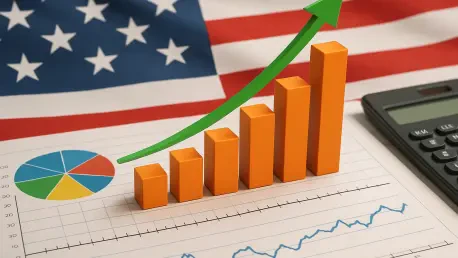The potential for the Federal Reserve to cut interest rates in the coming months has become a focal point of economic speculation. This consideration arises amid a landscape characterized by fluctuating economic indicators and varying market expectations. The Federal Reserve, tasked with maintaining economic stability, often revisits monetary policy to adapt to emerging economic needs. Market participants and analysts are closely observing signs that might presage a shift in the Fed’s stance. Currently, anticipation is heightened by comments from leading financial experts and economists, who perceive a greater likelihood of interest rate reductions by the fourth quarter.
Economic Indicators and Their Influence
An important aspect of this discourse involves scrutinizing the economic signals impacting the Federal Reserve’s deliberations on monetary policy. Inflation, growth rates, and employment statistics are critical indicators the Fed examines while formulating its policy decisions. Recent data suggest a mixed economic environment, with inflation rates showing varying degrees of stability and growth projections consistently wavering. Some sectors demonstrate resilience while others signal the need for caution and adjustment. Rising interest rates could further dampen business investments and consumer spending, making a compelling case for softer monetary policies to encourage growth. In response, many financial institutions express concerns about the possible repercussions should the Federal Reserve maintain its current stance without adjusting for these dynamics.
Understanding labor market trends also remains paramount as employment levels provide insight into the economy’s health. High employment and job security generally align with increased economic activity, but wage inflation might cause the Fed to reconsider rate reductions. The level of consumer and business confidence, evident in market surveys and spending patterns, equally informs the discussion around potential policy shifts. Until the labor market demonstrates significant positivity or distress, any movement in interest rates will hinge largely on other compelling economic indicators.
Potential Timing and Strategic Readjustments
The timing of a potential rate cut is critical as it plays into both immediate economic needs and long-term financial strategies. Current consensus suggests that the Federal Reserve considers a calibrated response, possibly delaying rate alterations until the latter half of the year. Anitza Nip, among other prominent economic voices, points to the unlikely nature of a July meeting rate cut, while suggesting a later timeframe could prove beneficial for addressing economic contingencies. This view is corroborated by analyses indicating that a cautious approach allows room for upcoming data to better guide policy adjustments.
Engaging with these strategic considerations, the Fed remains tasked with careful navigation between over-stimulation and necessary intervention. Financial modeling and forecasts are utilized to assess optimal timing and policy direction, ensuring that short-term actions do not undermine long-term objectives. Borrower-friendly rates may stimulate investments and consumer spending, yet excessively low rates could ignite inflationary concerns, adding complexity to the Fed’s decision matrix. These considerations delineate the parameters that the Federal Reserve likely weighs in deliberating any proposed monetary easing.
Global Economic Context
The global economic environment is another significant factor influencing the Federal Reserve’s decisions on interest rates. Economic interconnectedness means that domestic policy adjustments often reverberate worldwide, compelling the Fed to weigh global developments carefully. Recent fluctuations in international trade patterns, geopolitical tensions, and pandemic aftershocks present additional challenges for global economic players. These factors often exert pressure on the U.S. economy, compelling reassessment of anticipated monetary moves.
Global market trends underscore the potential for economic impacts to transcend national borders, with trade agreements and tariff negotiations factors in economic considerations. Exchange rate shifts and international capital flows also contribute to shaping monetary policy frameworks. Analysts frequently point to cross-border economic relationships as catalysts for monetary policy adaptation, noting that a comprehensive strategy is required to manage domestic growth vis-à-vis global trends. International efforts to stabilize economies may even put pressure on the Federal Reserve to align its policies with broader economic goals, fostering a synchronized economic recovery.
Considerations for Investors and Stakeholders
For investors, policymakers, and other stakeholders, the prospect of interest rate cuts carries significant implications. Investors and financial markets tend to react swiftly to shifts in Federal Reserve policies, which can overturn existing market expectations. Interest rate adjustments influence stocks, bonds, currencies, and commodities, emphasizing the need for proactive financial strategies. Investors are particularly vigilant for indicators heralding such changes, and market speculation often fuels anticipatory adjustments.
Policy circles must also weigh the implications of any shifts, considering fiscal and regulatory consequences. Government spending, taxation, and regulatory policies often intersect with monetary considerations, requiring intricate coordination across policy domains. In addressing national priorities such as housing affordability or infrastructure spending, a nuanced approach to interest rate settings may prove critical. Stakeholders demand clarity and predictability from policymakers who can significantly sway economic outcomes through informed, balanced action.
Balancing economic stimulation with inflation management underscores the complex nature of monetary policy in an interdependent world. Navigating these multidimensional challenges requires close monitoring of economic signals, timely analysis, and preemptive strategizing to ensure that fiscal and monetary policies foster prosperous and sustainable growth across industries and regions.
Forward-Looking Analysis and Concluding Observations
Speculation is rising around the possibility of the Federal Reserve slashing interest rates in the upcoming months. The discussion gains traction amidst a fluctuating economic environment and diverse market anticipations. The Federal Reserve, responsible for ensuring economic stability, routinely reviews its monetary policy to adjust to new economic conditions. Market observers and analysts are keenly watching for indicators that might suggest a forthcoming shift in the Fed’s policy. There is an increased buzz largely fueled by remarks from prominent financial leaders and economists, who believe there’s a growing probability that the Fed might lower interest rates by the fourth quarter.
The potential rate cut is largely seen as a reaction to various economic signals, including inflation rates, employment statistics, and global economic trends, which have recently shown mixed indications. A lower interest rate could stimulate economic activity by making borrowing cheaper for consumers and businesses. However, it’s a balancing act, as too much stimulus might lead to inflation, while too little could stifle economic growth. Analysts are balancing these factors and trying to predict the timing and extent of any rate adjustment. As we approach the fourth quarter, all eyes will be on the Fed and its decisions as they navigate these economic complexities.









